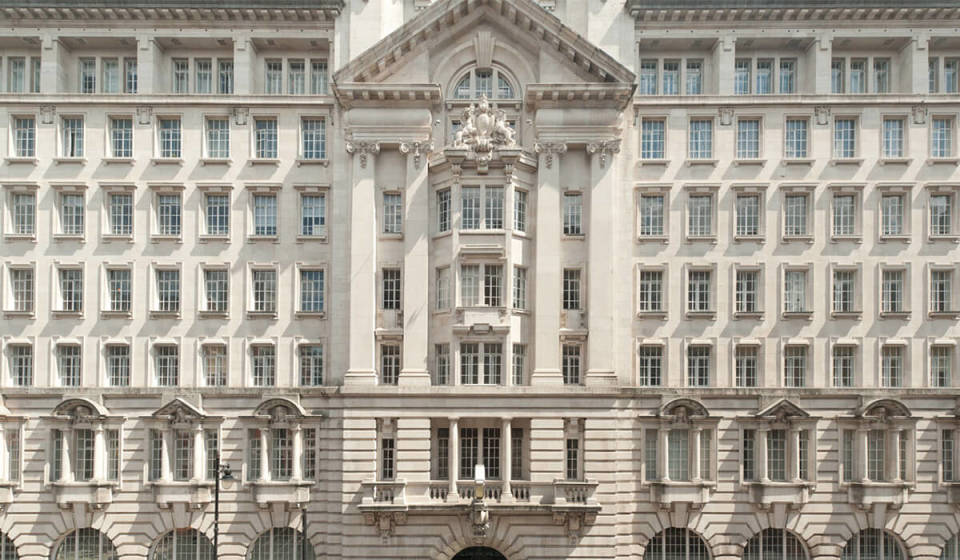The history of St James'
By Bruntwood

Considered one of Manchester’s most magnificent buildings St James’ was built in 1912 for the Calico Printers' Association (CPA) and is integral to both the textile history of the city and to its rich architecture. We take a trip down memory lane and look at the history of the building.
1884
St James’ takes its name from one of the two buildings which it replaced: St James’s Hall and Theatre. Built in 1884, the theatre became known for its heavy dramas and at the time of opening was the largest assembly hall space in the city centre holding 2,500 people. St James’s Theatre was owned by James Reilly, a man of great ambition, who also owned the popular botanical gardens and agricultural palace just beyond Castlefield at Pomona.
1890
Over the course of the theatre’s lifetime it would become home to the famous Tiller Girls school, set up by John Tiller who originally worked in the shipping industry and took up dancing aged 30. After great success in training girls for pantomime, Tiller quit his work in shipping and took up dance full time. His method was all about discipline, and the military-like routines he taught his troupe of dancers was to be coined ‘precision dancing’. It can be easily recognised by the dancers’ linked arms and synchronised high kicks. Throughout the 20th century the Tiller Girls were one of the world’s most prestigious dance troupes.
1906
As the Edwardians’ tastes inevitably changed, the theatre went into decline and in 1906 the building was put up for auction. Auctioneers suggested the building would be a prime location for government quarters, but it came as a surprise when the theatre didn’t sell and it was instead repurposed as the American Roller Skate Rink
1909
The building was finally sold to the CPA in 1909 and was demolished in June of that year to make way for their headquarters. The CPA believed in strength in numbers and the amalgamation of 46 textile printing companies and 13 merchants under one roof united those working in the textile trade. True to the nature of Manchester’s attitude at the time, they built on a grand scale in-keeping with the extravagance of the world’s first industrial city.
1912
St James' Building was one of the earliest steel-framed buildings in the country and was built by Clegg, Fryer and Penman. This was actually a partnership of two architectural practices and although this is unusual it was thought necessary to speed the building along. With a facade of portland stone, the Baroque warehouse stands out for its sheer scale. In fact, when opened, it was the largest commercial house in Manchester. It was a statement to dare to use white stone in a city still blackened by smog.
It’s speculated that the building may have been influenced by the Royal Liver Building in Liverpool which was completed a few years earlier. To be able to create the impressive site of today, two roads (Atlas Street and George Street) were built over, as was the Rochdale Canal. While the building was a far cry from its predecessor, not all traces of the theatre were destroyed as it’s believed that the foyer replicates many of the features of the theatre’s own entrance
1924
As testament to the varied skills of its workers, the CPA hosted an annual arts and crafts exhibition on site. Starting in 1924 the show was covered by The Guardian and drew in weekly crowds of 8,000 people. The exhibition showcased the finest handiwork of the CPA employees from around the world and included painting, photography, embroidered dresses, metalwork, furniture, rugs, fishing rods and even homemade radios. The show was part of the company’s welfare for employees scheme and all items were made outside of work during a resurgence in the popularity of handmade goods, no doubt sparked by the austerity of wartime.
1930
St James’ building transformed the diversity of the neighbourhood from one previously dominated by theatres to one of commerce and skilled labourers. The surrounding theatres, cinemas, and dance clubs would remain popular, and up until the mid 60s they were a regular lunchtime outing for the CPA staff. The nearby Plaza held lunchtime discos, but the queues could be so large that the employees of St James’ would often roller skate or play cricket on the roof instead.
1968
CPA left their headquarters in 1968, around the time they merged with English Sewing Cotton Company to form English Calico Ltd, which changed its name to Tootal Ltd in 1973.
2018
The Grade II listed building is located on Oxford Street just before the highway becomes Oxford Road. The subtle change from street to road signifies the former borders of the city centre. The road served to transport people to the city whilst the streets carried people around it. St James’ was situated at that gateway, where the slums of Little Ireland and the town of Chorlton Upon Medlock met the true heart of the city. Details of that industrial city can be spotted to the rear of St James’ with evidence of pipe lagging from the Bloom Street power station found on the external walls. These pipes carried steam around the city and powered its hydraulic systems including the curtain at the Palace Theatre and the lifts at John Rylands Library. There’s also a curious bit of street furniture just beneath the lagging in the form of a Victorian stink pipe; an ornate lamp post which burnt off gas from the sewers.
Today, the building’s oldest tenant is St James’ Safe Deposit Co Ltd who have been in the basement since opening. Boxes were available to all employees of the CPA as well a room dedicated to public use and one of these strong rooms is still painted in the original cream and brown company colours.